– Text and Photos © Carmen Franco for Eurodressage
Every year in January U.S. based dressage lovers with nationalities from all over the world gather at Mary Anne and Walter McPhail’s beautiful High Meadows Farm at White Fences in Loxahatchee, Florida, for one of the main USDF programs: the USDF FEI Level Trainers Conference.
This year more than 300 people came to the fantastic covered arena to watch Olympians Sven Rothenberger, Sabine Schut-Kery, and retired judge Lilo Fore as moderator, work with eight horse/rider combinations selected from a variety of applicants.
“If you do dressage, you will face a lifetime of criticism”
A quick note before we get to the action: I want to express how much I admire the riders that put themselves in front of all of us to help us learn. As Rothenberger stated, “if you do dressage, you will face a lifetime of criticism.” This is no easy task and I thank them, together with their horses and teams, for it.
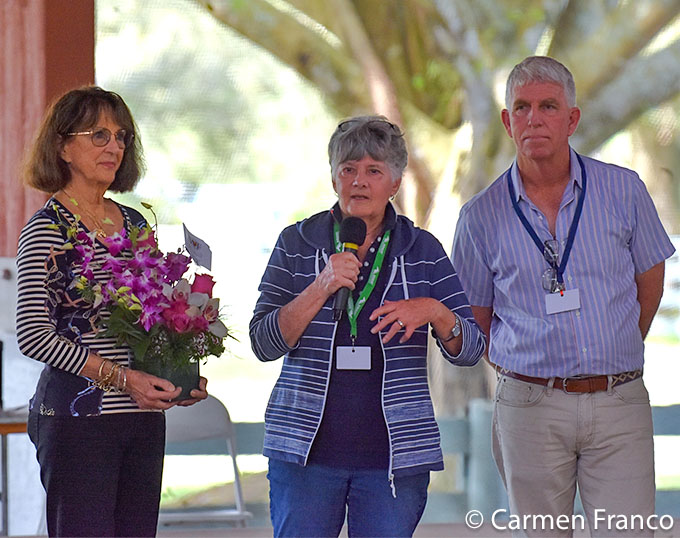
Beth Baumert and George Williams
When doing these reports, it’s very important to point out the work that was suggested at the moment for that particular horse/rider combination, sometimes it worries me to quote the clinician and get things taken out of context.
Without a much longer preamble, let’s go directly to what they worked on! Here is part 1.
Forward is a Lifestyle
Bonnie Canter and the 7-year old Hanoverian gelding Vitali (by Vilancio x Jazz Time x Wertschatz) started the day showing a bit of their warm-up. Even though they went around in a beautiful shape and fluent movements, Sabine immediately pinpointed a few lacking details to produce better results. She wanted him to be sharper to the aids, while stressing Bonnie not to sacrifice her position. “Careful not to make the job of the horse, he needs to be more reliable.”
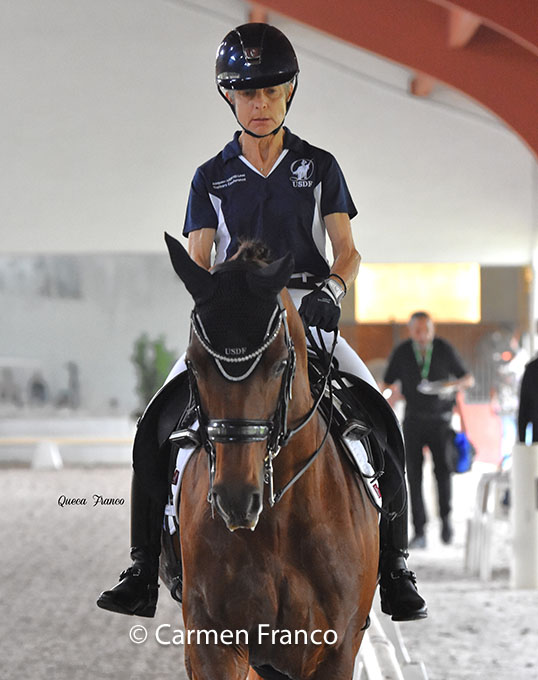
Through transitions they began to look in better harmony, although Sabine corrected the precision of the execution several times. Some of the lines taken were 4 loops serpentines with transitions canter-walk crossing the center line and then with flying changes. In the transitions, she wanted him to step under with activity into the new gait, not just pull away from the rider, and when working on keeping the activity, they were reminded not to speed up. To help the longitudinal suppleness, they were asked to do many 10 mt. volte concentrating on maintaining the same tempo and balance throughout. The more he got supple in the bending, the better his reactions were to the aids.
Another movement used to help put Vitali together was the leg-yield in canter from the center line to the track. “When you feel him trying to break to trot from canter, don’t chase him, instead ride a turn or circle so you teach him to bring the hindleg under into engagement.” They also used quarter pirouettes at the walk, and 20-meter circles in shoulder-in. When the collection got better, he wanted to get hesitant maintaining rhythm of the canter, to what Sabine suggested to use the hip to support the leg action but reminded her to keep high standards in her position: long legs, heels down, supple hands. “Forward is a lifestyle” this is the key to everything.
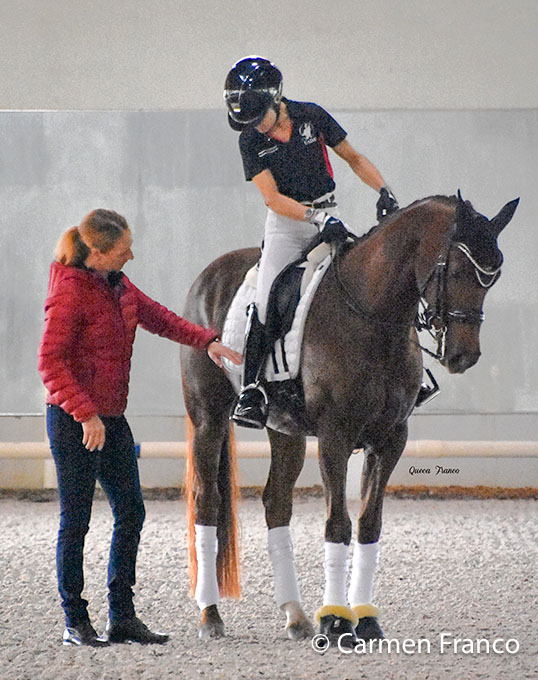
saddle pad on Vitali
On the second day, they worked on Intermediate I movements. For the preparation Sabine told Bonnie to use lines to help Vitali articulate his mid-section, like shallow loops and volte. To improve the balance and collection, it was suggested to take more strides in each corner. The rider’s aids should become quicker if the horse needs to get quicker reactions. When performing the trot tour, Sabine asked for attention to detail in each movement, stressing also that the conformation of the horse will dictate how to ride it: if the neck is too high, ride it low and vice versa. There were several reminders to the rider to stay swinging with the body, including the hands, matching the rhythm of the horse. “Be like an orchestra conductor, you help with the rhythm, but the musicians still must play their part of the music.”
And this other quote referred to the same: “produce a thinking horse, not a robot. There must be a partnership.”
Horsemanship Required
Kelsey Dunlap and the 9-year old Hanoverian Heirendale SBF (by Hotline x Rabino x Grannus) were guided by Sabine too. During the warm-up, the horse wanted to be a bit long and quick, so they worked on exercises to help with longitudinal thoroughness and engagement. Changing the tempo at the trot, or riding transitions between gaits, helped articulate the hindleg. A few times Heirendale wanted to overreact to what Kelsey was told, to open the neck, to reassure him with a pat in the neck. “He needs to be comfortable with the challenges.” They went also to work on collecting and going forward in a circle, then into a shoulder in. In the transition from walk to trot, she was asked to think of piaffe to get hindlegs quicker and under, but to be sure he doesn’t move like a marionette, with just the legs going up and down, his body needs to be involved. “It requires horsemanship to know how much to repeat and challenge a horse without drilling and breaking its soul.”
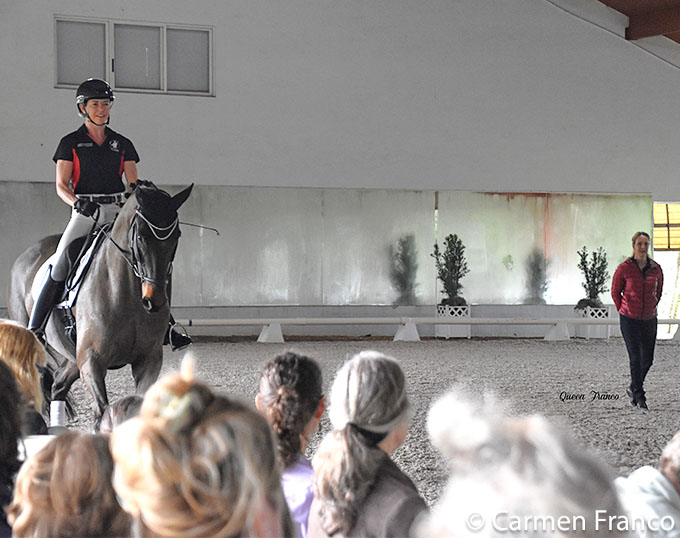
When asking for the canter she was reminded not to let him pull the movement out of the shoulders but to propel from the back legs. Forward on the long side between R and P, then 12 mt. volte was the exercise to keep bringing the hindlegs into engagement. When riding forward, pay attention to the rhythm: don’t chase him, he needs to cover ground. At the end of the session, both Sven and Lilo thought Heirendale was a talented horse. They suggested to keep helping him find coordination, for example with the whip, not as a punishment, but to make him use the hindlegs more honestly. Because he is big and got tense a few times, they suggested to work with calmness: “Every drop of water can move a stone.”
On the second day, he looked more relaxed from the beginning, but they reiterated how important it was to keep finding suppleness with his emotional, claustrophobic reactions. They worked lateral movements at the trot and played with the size of the stride, trying to avoid getting him over stressed. “If the horse is not mentally relaxed, it can’t learn the information given.” Sabine remarked that emotional horses need riders, trainers and owners that can give them the time needed. “Praising is not only giving sugar or patting in the neck, but also quitting movements at the correct time.”
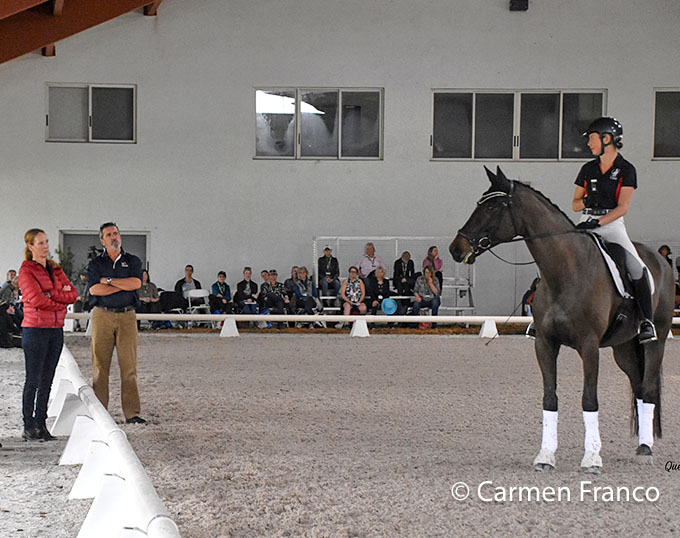
The good use of the Training Scale will make the tense horse relax and the unmotivated horse more rideable. At the canter they repeated a few 8 mt. volte insisting on keeping the same tempo and balance. To help prepare for pirouettes they worked haunches in in a 20 mt circle, when feeling a better engagement, Kelsey was asked to turn his shoulders two strides to the inside. They also went to work on spiral into the circle, being sure that the inside leg helps maintaining the shape of the bending. During one of the walk breaks, Sabine asked them to do leg yielding on sharp angles to get more separation from the hindlegs and access into the ribcage. She concluded: “This is not easy!”
Test Information
During the warm-up, Marjolein Geven on the 16-year old Hanoverian gelding Sir Frederico (by Sandro Hit x Don Frederico) was reminded not to do the job for him and to be proactive with the hands: to let the energy go out without losing the balance. As with the previous horses, they went to open and collect strides, letting the corner help to bring him back and insisting on not letting him shut down. To maintain his activity, they were asked to change the tempo between letter and letter.
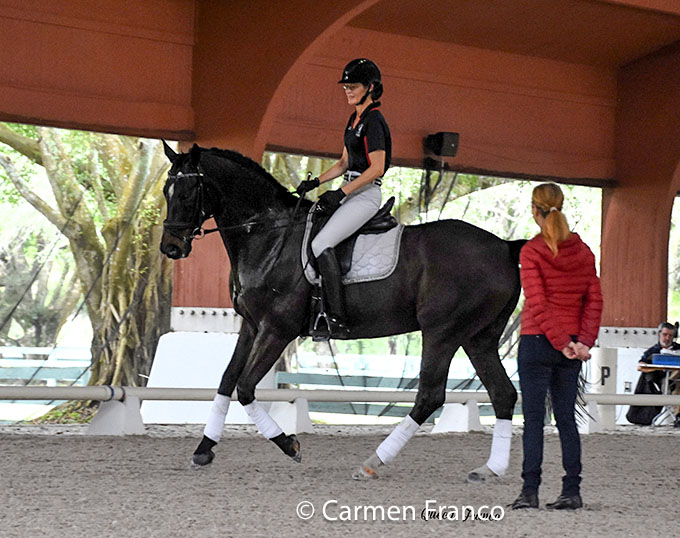
“When we follow the path of the tests, there is a lot of training information behind the movements.” But we need to understand why the transitions are there and not to repeat the tests blindly. For example, the transition from canter to trot in the Grand Prix is there to prove the throughness.
Another important piece of this session was the straightness, meaning that right and left side should be equally available; the hindlegs should follow the footprint of the front legs. The rider must be picky about it as it plays a big role in the collection and the relationship between push and carrying power.
With horses that have “history” it’s better to do 5 good minutes, than going around for longer time with less quality. Raise the bar of your work so you can achieve those good 5 minutes.
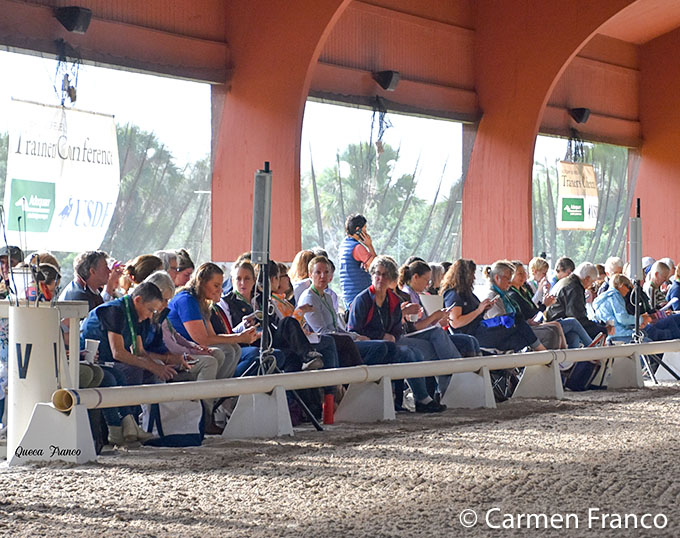
On the second day, the horse looked more honest in the frame, balance, and connection, with lighter aids of the rider. Sabine remarked that the better the horse is on the basics, the easier the “tricks” become. They worked on pirouettes at the canter preparing with a diagonal to X, followed by an 8 m volte at X, then a 5 m, then the pirouette. After that, they worked on half steps and passage. Each horse is different, and Sabine thought the approach to piaffe was easier from the trot in this case. To help the action of the hindleg, Marjolein was asked to tap with the whip on the hock, not on the butt as that will produce more bounce. She was also encouraged to stay longer in the piaffe and when feeling losing the energy, to turn 90 degrees or a few steps, that helps putting weight on the hindleg while maintaining the horse thinking forward.
Sabine really took advantage of walk breaks and this time she asked them to perform a 4-loop serpentine to improve the bend on both sides. This lateral suppleness will improve the rideability all around. “In riding tests, the new movement depends on the past one, you better ride everything for an 8!”
Basics, Basics, Basics
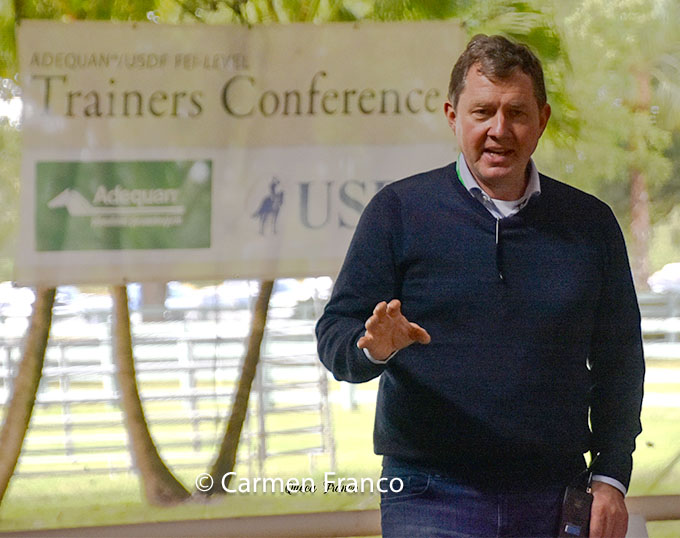
It was Sven Rothenberger’s turn to work with Molly O’Brien and the 7-year old Oldenburg stallion Fortunato H2O (by Floriscount x Rascalino). He was very complimentary of “Tuna’s” looks and gaits. Because Molly is a tiny rider on a big horse, he started pointing out details to improve their performance together. Important to remark that, even though Tuna has an outstanding walk, it needs to be ridden correctly. Either extended or collected, with definition on the connection and activity. “Extended walk needs to look like going through the forest, with a purpose.”
During the trot warm-up, he got the tendency to be behind the leg to what Sven suggested to bump with the leg and let go with the hand at same time. The session went on with lateral movements at the trot and then walk – canter transitions, using lines towards the fence to help them be more defined. Sven joked, “he will not jump out of the ring with that breeding!” Molly was encouraged many times to give with the reins to test and proof the self-carriage and she was reminded to keep him sharp to her legs. “With a horse of this quality, you need to concentrate not to make mistakes.”
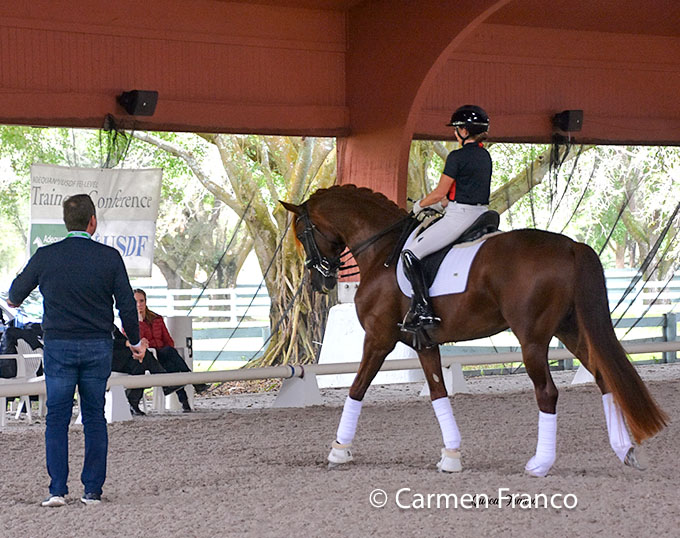
After the warm-up they went on to work on movements for the Prix St. Georges, when Sven clarified that systematic building up to that level, doesn’t mean to do the same lines all the time. “You must reach every day the same suppleness, throughness, straightness, etc. not repeat all the movements again and again. I love the Pr. St. Georges because you can see the quality of the horse.”
When working on pirouettes, he suggested to school quarter turns as it will be easier to get out of them, than from half or full ones. While correcting details on all they were working on, he advised not to execute movements if the basics are not met.
On the second day, Tuna came with a single snaffle instead of a double bridle. Sven liked the move, saying he thought this was a better option. In this session he really insisted on Molly’s position, to get longer lines out of her body, and not to lean back. “Only through a good seat, you can develop good riding.”
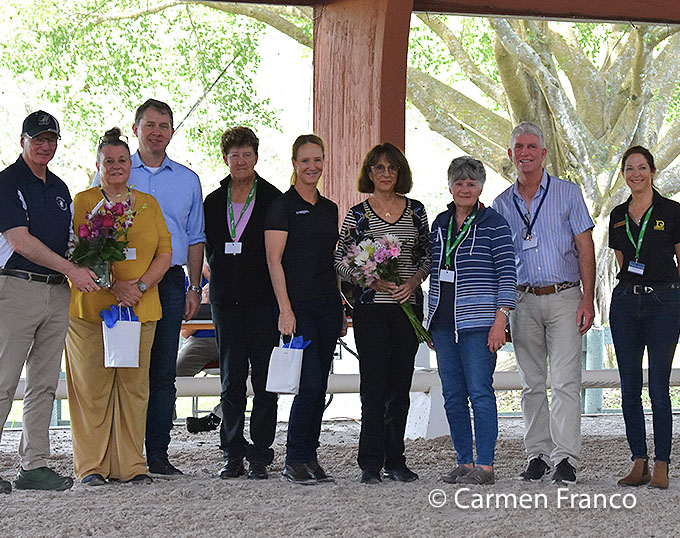
It will be too long to describe all the transitions and lines they worked on; but the idea summarizes in the precision a rider should have in everything that is performed with the horse. “If a mistake happens, don’t make more, be picky about every single detail!”
– Text and Photos © Carmen Franco for Eurodressage
Part II coming soon
Related Links
Nuggets of Wisdom from the 2023 USDF FEI Level Trainers’ Conference
Carl Hester’s Wisdom: “Dedicate Yourself to Get Better, Nobody is Perfect”
McDonald, Traurig, Williams, Bredahl to Speak at 2019 USDF FEI-Level Trainers Conference
2018 USDF FEI-Level Trainers Conference with Johann Hinnemann in Del Mar, California
Demo Riders for 2018 USDF FEI-Level Trainers Conference
Hinnemann and Clarke to Head 2016 USDF Trainers Conference
Stephen Clarke to lead 2015 USDF FEI-Level Trainers Conference
Steffen Peters and Scott Hassler Headlining USDF FEI-Level Trainers’ Conference

